MBA Global Business Report: IKEA's Entry into the Indian Market
VerifiedAdded on 2022/12/16
|6
|1503
|99
Report
AI Summary
This report provides a comprehensive analysis of IKEA's entry into the Indian market. It begins by identifying three key policy obstacles to foreign direct investment (FDI) in India, including high tariffs and protectionist policies, rigid licensing requirements and high tax rates, and an inefficient judiciary system. The report then delves into the challenges IKEA faces in India, such as intense low-cost competition and the difficulty of securing affordable store locations. It also examines IKEA's prospects, particularly its focus on the upper-middle class and the potential for adapting products to suit Indian kitchens. The report concludes that while IKEA is a well-established global brand, its success in India depends on navigating policy hurdles and adapting to the unique characteristics of the Indian market. The report uses various academic sources to support its findings.
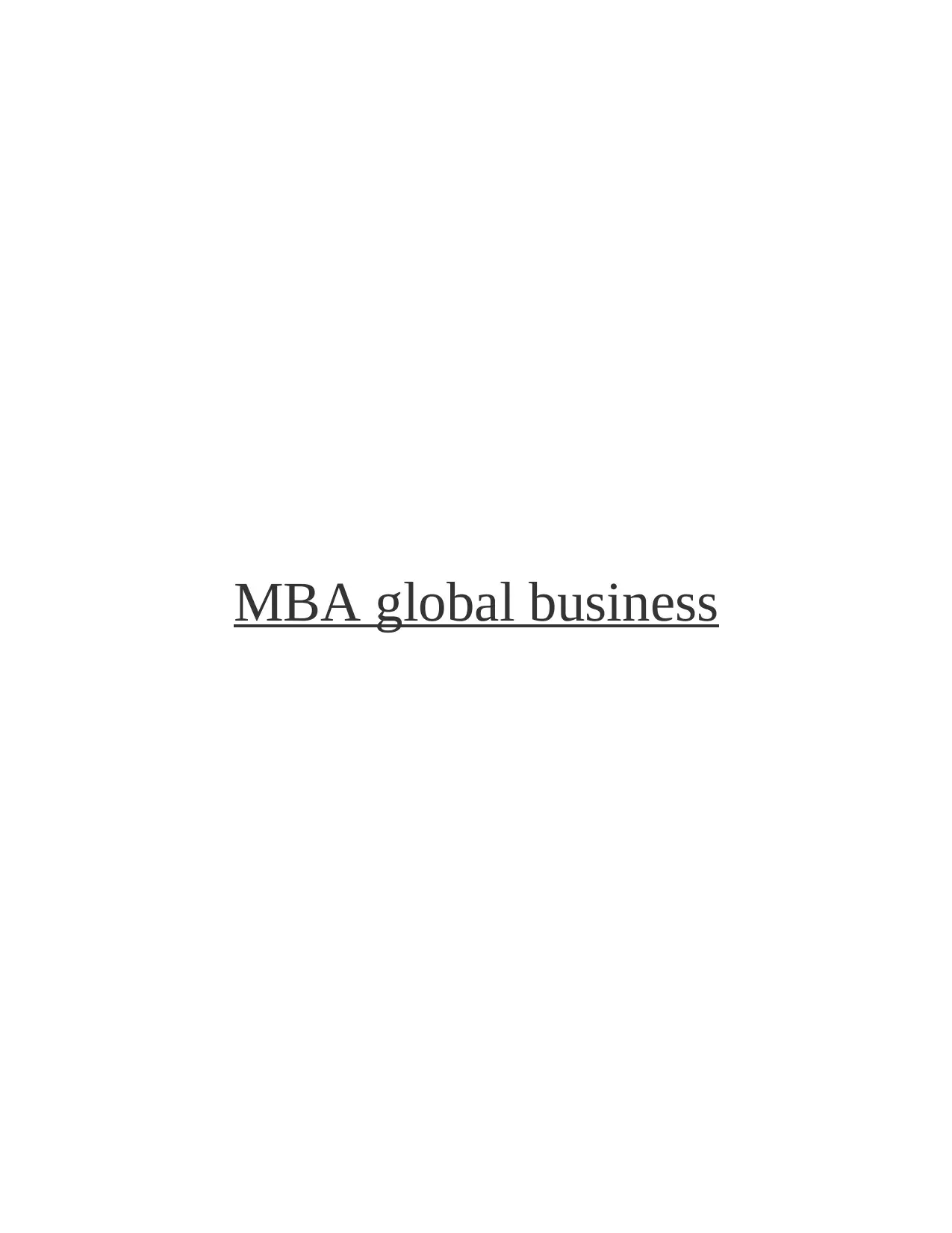
MBA global business
Secure Best Marks with AI Grader
Need help grading? Try our AI Grader for instant feedback on your assignments.
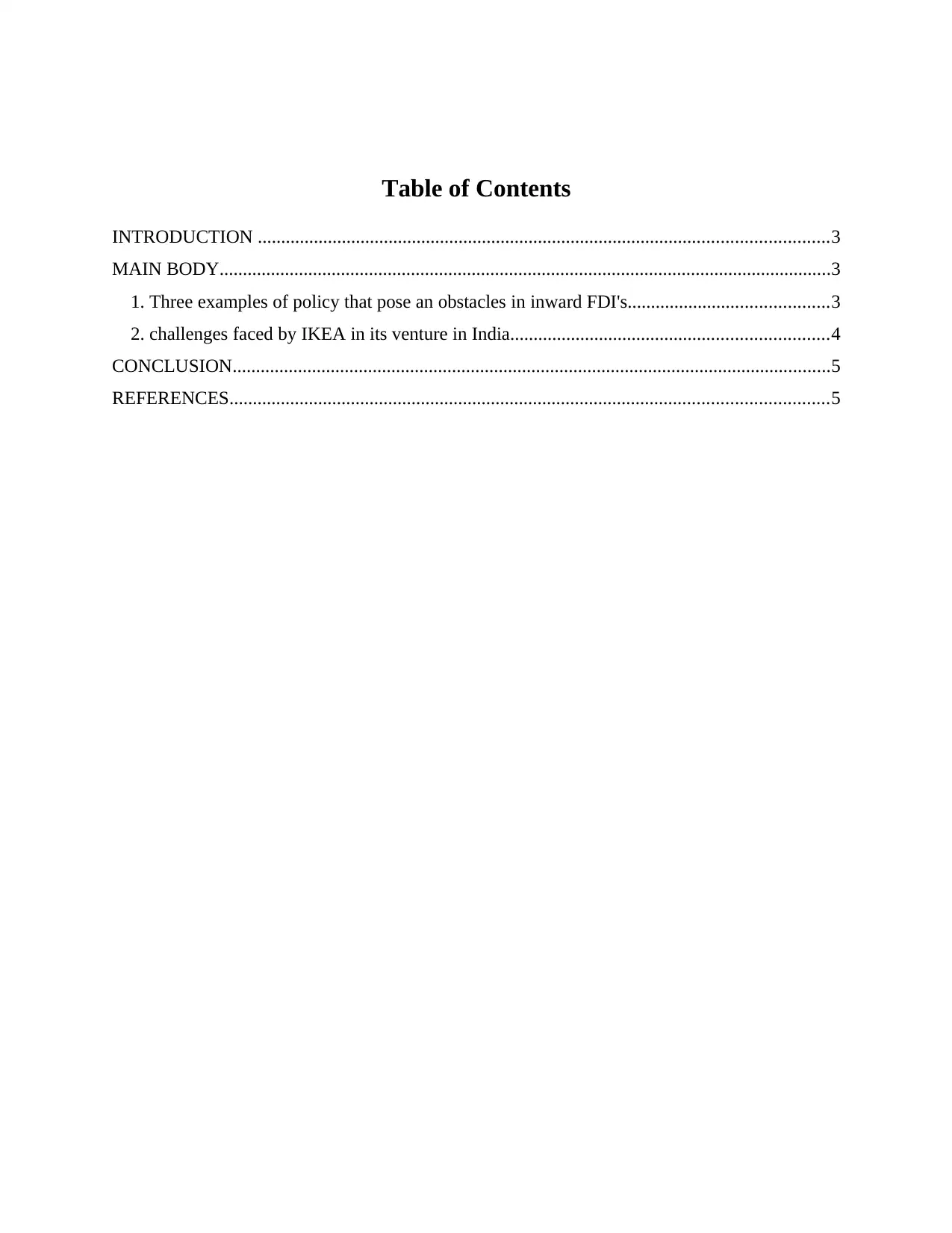
Table of Contents
INTRODUCTION ..........................................................................................................................3
MAIN BODY...................................................................................................................................3
1. Three examples of policy that pose an obstacles in inward FDI's...........................................3
2. challenges faced by IKEA in its venture in India....................................................................4
CONCLUSION................................................................................................................................5
REFERENCES................................................................................................................................5
INTRODUCTION ..........................................................................................................................3
MAIN BODY...................................................................................................................................3
1. Three examples of policy that pose an obstacles in inward FDI's...........................................3
2. challenges faced by IKEA in its venture in India....................................................................4
CONCLUSION................................................................................................................................5
REFERENCES................................................................................................................................5
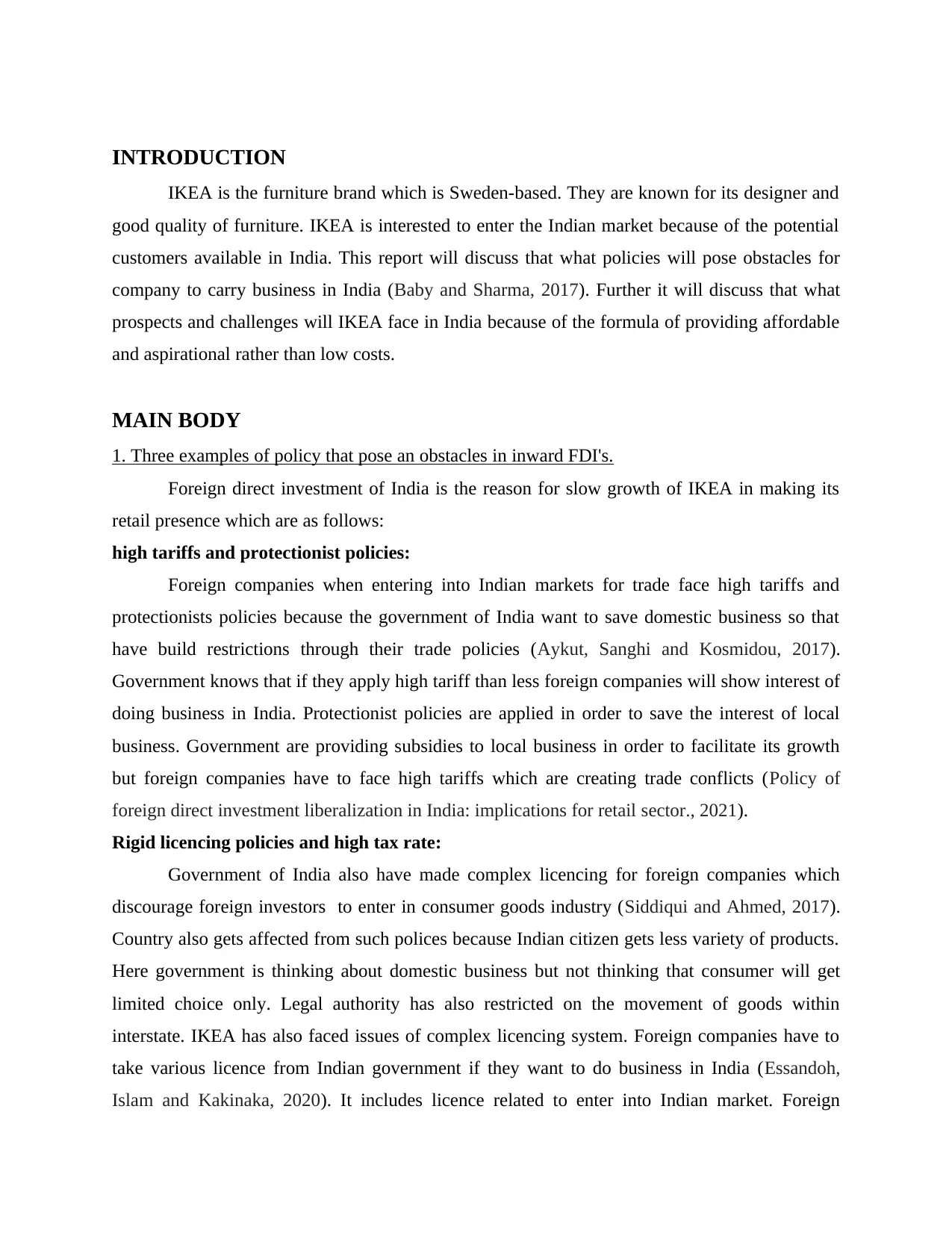
INTRODUCTION
IKEA is the furniture brand which is Sweden-based. They are known for its designer and
good quality of furniture. IKEA is interested to enter the Indian market because of the potential
customers available in India. This report will discuss that what policies will pose obstacles for
company to carry business in India (Baby and Sharma, 2017). Further it will discuss that what
prospects and challenges will IKEA face in India because of the formula of providing affordable
and aspirational rather than low costs.
MAIN BODY
1. Three examples of policy that pose an obstacles in inward FDI's.
Foreign direct investment of India is the reason for slow growth of IKEA in making its
retail presence which are as follows:
high tariffs and protectionist policies:
Foreign companies when entering into Indian markets for trade face high tariffs and
protectionists policies because the government of India want to save domestic business so that
have build restrictions through their trade policies (Aykut, Sanghi and Kosmidou, 2017).
Government knows that if they apply high tariff than less foreign companies will show interest of
doing business in India. Protectionist policies are applied in order to save the interest of local
business. Government are providing subsidies to local business in order to facilitate its growth
but foreign companies have to face high tariffs which are creating trade conflicts (Policy of
foreign direct investment liberalization in India: implications for retail sector., 2021).
Rigid licencing policies and high tax rate:
Government of India also have made complex licencing for foreign companies which
discourage foreign investors to enter in consumer goods industry (Siddiqui and Ahmed, 2017).
Country also gets affected from such polices because Indian citizen gets less variety of products.
Here government is thinking about domestic business but not thinking that consumer will get
limited choice only. Legal authority has also restricted on the movement of goods within
interstate. IKEA has also faced issues of complex licencing system. Foreign companies have to
take various licence from Indian government if they want to do business in India (Essandoh,
Islam and Kakinaka, 2020). It includes licence related to enter into Indian market. Foreign
IKEA is the furniture brand which is Sweden-based. They are known for its designer and
good quality of furniture. IKEA is interested to enter the Indian market because of the potential
customers available in India. This report will discuss that what policies will pose obstacles for
company to carry business in India (Baby and Sharma, 2017). Further it will discuss that what
prospects and challenges will IKEA face in India because of the formula of providing affordable
and aspirational rather than low costs.
MAIN BODY
1. Three examples of policy that pose an obstacles in inward FDI's.
Foreign direct investment of India is the reason for slow growth of IKEA in making its
retail presence which are as follows:
high tariffs and protectionist policies:
Foreign companies when entering into Indian markets for trade face high tariffs and
protectionists policies because the government of India want to save domestic business so that
have build restrictions through their trade policies (Aykut, Sanghi and Kosmidou, 2017).
Government knows that if they apply high tariff than less foreign companies will show interest of
doing business in India. Protectionist policies are applied in order to save the interest of local
business. Government are providing subsidies to local business in order to facilitate its growth
but foreign companies have to face high tariffs which are creating trade conflicts (Policy of
foreign direct investment liberalization in India: implications for retail sector., 2021).
Rigid licencing policies and high tax rate:
Government of India also have made complex licencing for foreign companies which
discourage foreign investors to enter in consumer goods industry (Siddiqui and Ahmed, 2017).
Country also gets affected from such polices because Indian citizen gets less variety of products.
Here government is thinking about domestic business but not thinking that consumer will get
limited choice only. Legal authority has also restricted on the movement of goods within
interstate. IKEA has also faced issues of complex licencing system. Foreign companies have to
take various licence from Indian government if they want to do business in India (Essandoh,
Islam and Kakinaka, 2020). It includes licence related to enter into Indian market. Foreign
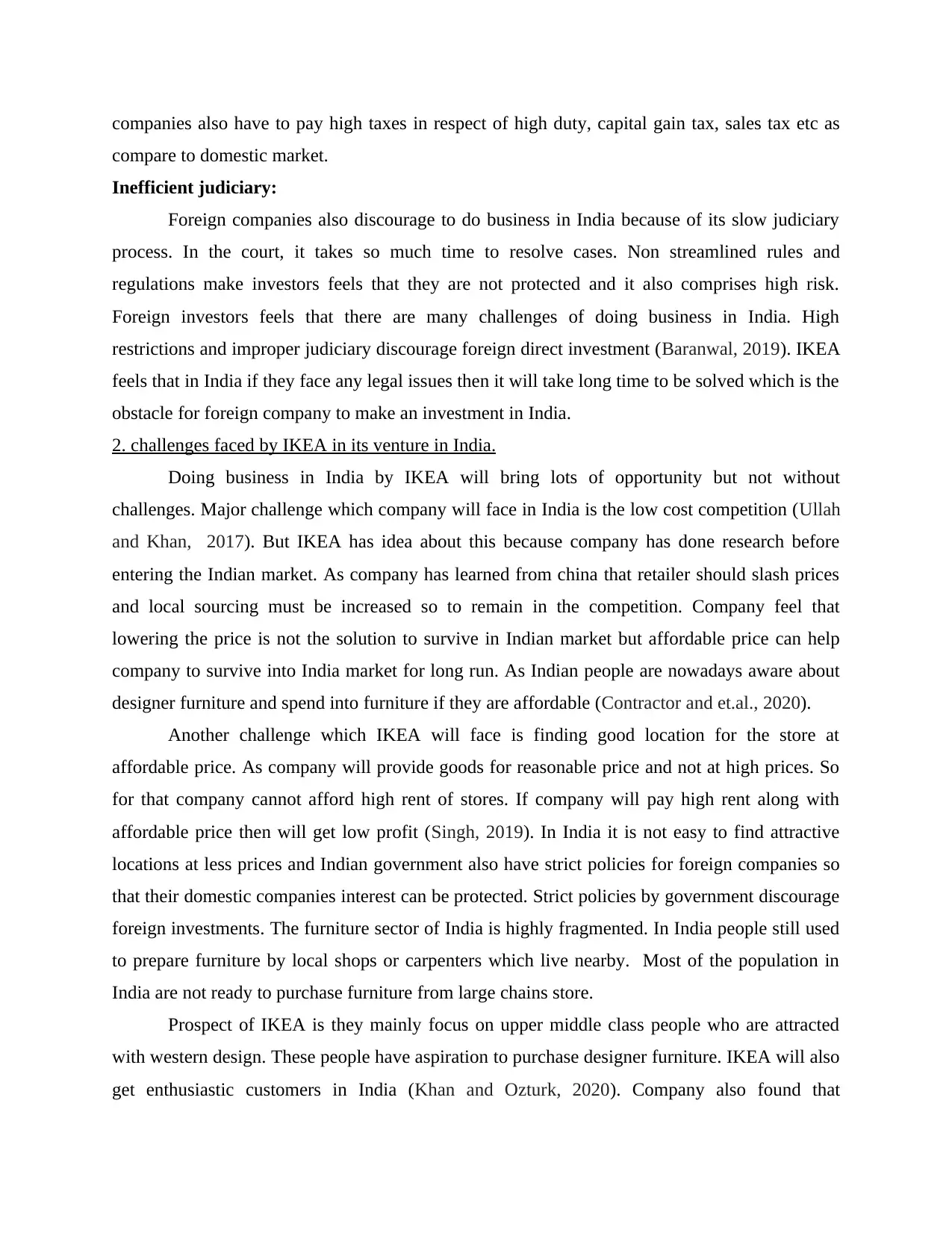
companies also have to pay high taxes in respect of high duty, capital gain tax, sales tax etc as
compare to domestic market.
Inefficient judiciary:
Foreign companies also discourage to do business in India because of its slow judiciary
process. In the court, it takes so much time to resolve cases. Non streamlined rules and
regulations make investors feels that they are not protected and it also comprises high risk.
Foreign investors feels that there are many challenges of doing business in India. High
restrictions and improper judiciary discourage foreign direct investment (Baranwal, 2019). IKEA
feels that in India if they face any legal issues then it will take long time to be solved which is the
obstacle for foreign company to make an investment in India.
2. challenges faced by IKEA in its venture in India.
Doing business in India by IKEA will bring lots of opportunity but not without
challenges. Major challenge which company will face in India is the low cost competition (Ullah
and Khan, 2017). But IKEA has idea about this because company has done research before
entering the Indian market. As company has learned from china that retailer should slash prices
and local sourcing must be increased so to remain in the competition. Company feel that
lowering the price is not the solution to survive in Indian market but affordable price can help
company to survive into India market for long run. As Indian people are nowadays aware about
designer furniture and spend into furniture if they are affordable (Contractor and et.al., 2020).
Another challenge which IKEA will face is finding good location for the store at
affordable price. As company will provide goods for reasonable price and not at high prices. So
for that company cannot afford high rent of stores. If company will pay high rent along with
affordable price then will get low profit (Singh, 2019). In India it is not easy to find attractive
locations at less prices and Indian government also have strict policies for foreign companies so
that their domestic companies interest can be protected. Strict policies by government discourage
foreign investments. The furniture sector of India is highly fragmented. In India people still used
to prepare furniture by local shops or carpenters which live nearby. Most of the population in
India are not ready to purchase furniture from large chains store.
Prospect of IKEA is they mainly focus on upper middle class people who are attracted
with western design. These people have aspiration to purchase designer furniture. IKEA will also
get enthusiastic customers in India (Khan and Ozturk, 2020). Company also found that
compare to domestic market.
Inefficient judiciary:
Foreign companies also discourage to do business in India because of its slow judiciary
process. In the court, it takes so much time to resolve cases. Non streamlined rules and
regulations make investors feels that they are not protected and it also comprises high risk.
Foreign investors feels that there are many challenges of doing business in India. High
restrictions and improper judiciary discourage foreign direct investment (Baranwal, 2019). IKEA
feels that in India if they face any legal issues then it will take long time to be solved which is the
obstacle for foreign company to make an investment in India.
2. challenges faced by IKEA in its venture in India.
Doing business in India by IKEA will bring lots of opportunity but not without
challenges. Major challenge which company will face in India is the low cost competition (Ullah
and Khan, 2017). But IKEA has idea about this because company has done research before
entering the Indian market. As company has learned from china that retailer should slash prices
and local sourcing must be increased so to remain in the competition. Company feel that
lowering the price is not the solution to survive in Indian market but affordable price can help
company to survive into India market for long run. As Indian people are nowadays aware about
designer furniture and spend into furniture if they are affordable (Contractor and et.al., 2020).
Another challenge which IKEA will face is finding good location for the store at
affordable price. As company will provide goods for reasonable price and not at high prices. So
for that company cannot afford high rent of stores. If company will pay high rent along with
affordable price then will get low profit (Singh, 2019). In India it is not easy to find attractive
locations at less prices and Indian government also have strict policies for foreign companies so
that their domestic companies interest can be protected. Strict policies by government discourage
foreign investments. The furniture sector of India is highly fragmented. In India people still used
to prepare furniture by local shops or carpenters which live nearby. Most of the population in
India are not ready to purchase furniture from large chains store.
Prospect of IKEA is they mainly focus on upper middle class people who are attracted
with western design. These people have aspiration to purchase designer furniture. IKEA will also
get enthusiastic customers in India (Khan and Ozturk, 2020). Company also found that
Secure Best Marks with AI Grader
Need help grading? Try our AI Grader for instant feedback on your assignments.
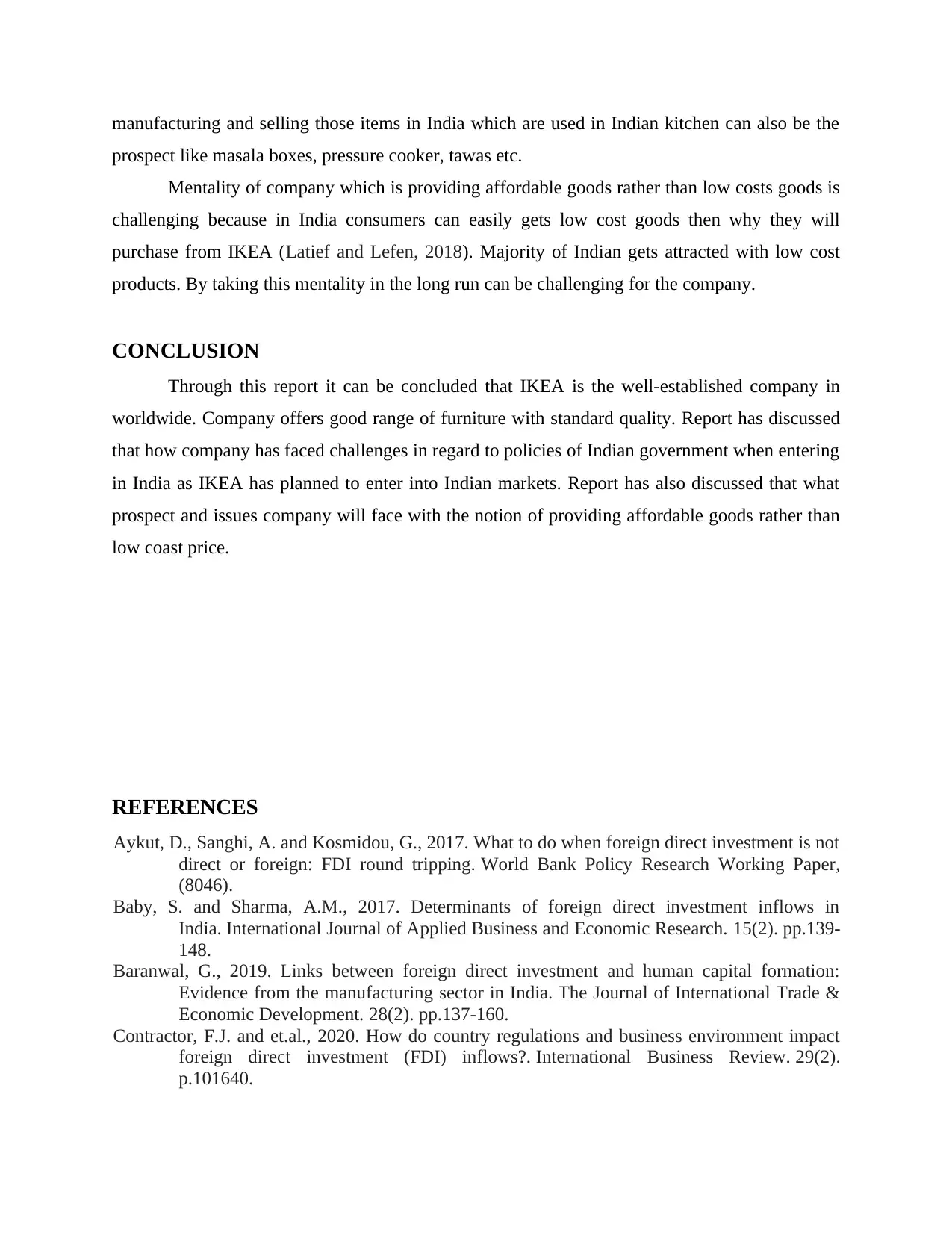
manufacturing and selling those items in India which are used in Indian kitchen can also be the
prospect like masala boxes, pressure cooker, tawas etc.
Mentality of company which is providing affordable goods rather than low costs goods is
challenging because in India consumers can easily gets low cost goods then why they will
purchase from IKEA (Latief and Lefen, 2018). Majority of Indian gets attracted with low cost
products. By taking this mentality in the long run can be challenging for the company.
CONCLUSION
Through this report it can be concluded that IKEA is the well-established company in
worldwide. Company offers good range of furniture with standard quality. Report has discussed
that how company has faced challenges in regard to policies of Indian government when entering
in India as IKEA has planned to enter into Indian markets. Report has also discussed that what
prospect and issues company will face with the notion of providing affordable goods rather than
low coast price.
REFERENCES
Aykut, D., Sanghi, A. and Kosmidou, G., 2017. What to do when foreign direct investment is not
direct or foreign: FDI round tripping. World Bank Policy Research Working Paper,
(8046).
Baby, S. and Sharma, A.M., 2017. Determinants of foreign direct investment inflows in
India. International Journal of Applied Business and Economic Research. 15(2). pp.139-
148.
Baranwal, G., 2019. Links between foreign direct investment and human capital formation:
Evidence from the manufacturing sector in India. The Journal of International Trade &
Economic Development. 28(2). pp.137-160.
Contractor, F.J. and et.al., 2020. How do country regulations and business environment impact
foreign direct investment (FDI) inflows?. International Business Review. 29(2).
p.101640.
prospect like masala boxes, pressure cooker, tawas etc.
Mentality of company which is providing affordable goods rather than low costs goods is
challenging because in India consumers can easily gets low cost goods then why they will
purchase from IKEA (Latief and Lefen, 2018). Majority of Indian gets attracted with low cost
products. By taking this mentality in the long run can be challenging for the company.
CONCLUSION
Through this report it can be concluded that IKEA is the well-established company in
worldwide. Company offers good range of furniture with standard quality. Report has discussed
that how company has faced challenges in regard to policies of Indian government when entering
in India as IKEA has planned to enter into Indian markets. Report has also discussed that what
prospect and issues company will face with the notion of providing affordable goods rather than
low coast price.
REFERENCES
Aykut, D., Sanghi, A. and Kosmidou, G., 2017. What to do when foreign direct investment is not
direct or foreign: FDI round tripping. World Bank Policy Research Working Paper,
(8046).
Baby, S. and Sharma, A.M., 2017. Determinants of foreign direct investment inflows in
India. International Journal of Applied Business and Economic Research. 15(2). pp.139-
148.
Baranwal, G., 2019. Links between foreign direct investment and human capital formation:
Evidence from the manufacturing sector in India. The Journal of International Trade &
Economic Development. 28(2). pp.137-160.
Contractor, F.J. and et.al., 2020. How do country regulations and business environment impact
foreign direct investment (FDI) inflows?. International Business Review. 29(2).
p.101640.
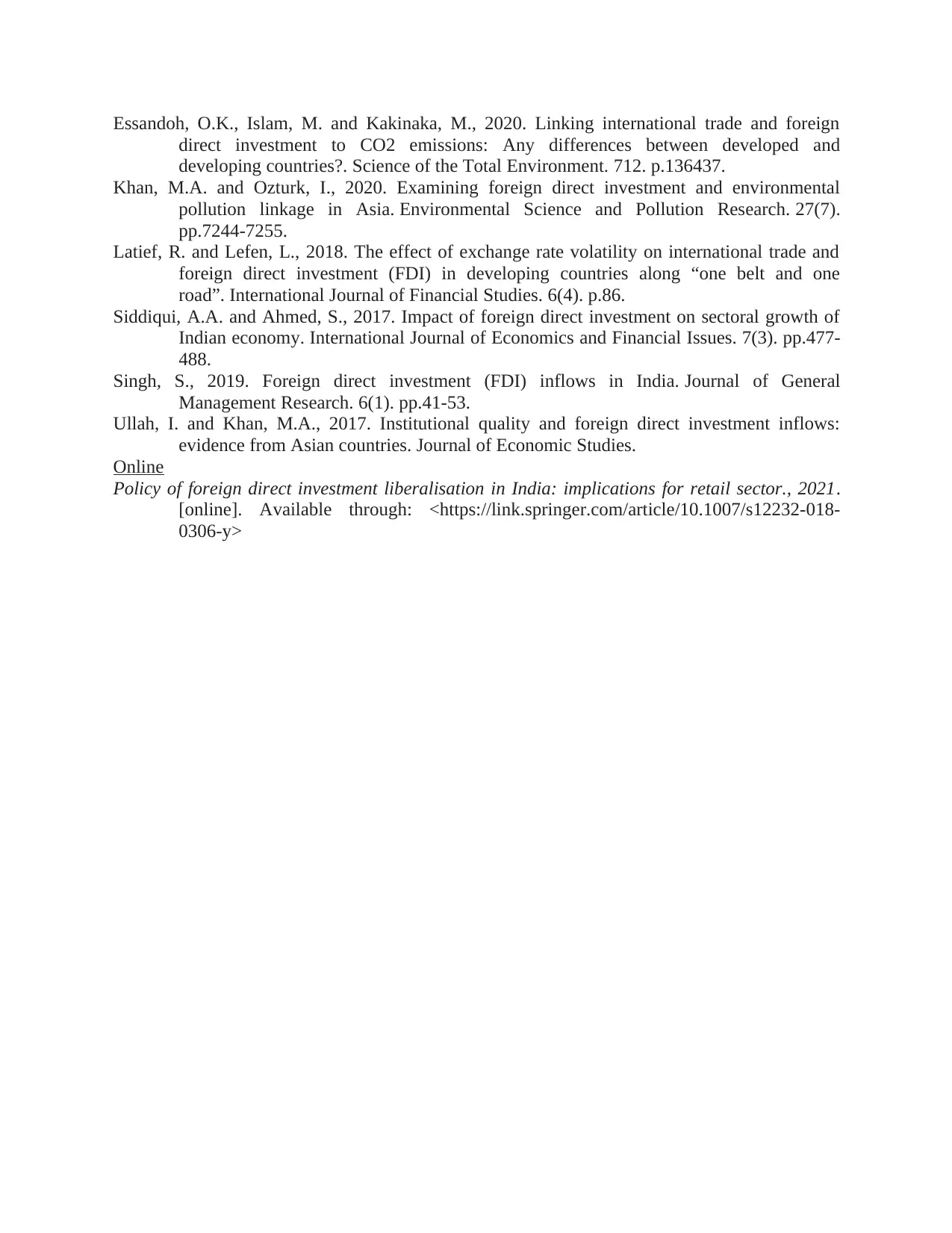
Essandoh, O.K., Islam, M. and Kakinaka, M., 2020. Linking international trade and foreign
direct investment to CO2 emissions: Any differences between developed and
developing countries?. Science of the Total Environment. 712. p.136437.
Khan, M.A. and Ozturk, I., 2020. Examining foreign direct investment and environmental
pollution linkage in Asia. Environmental Science and Pollution Research. 27(7).
pp.7244-7255.
Latief, R. and Lefen, L., 2018. The effect of exchange rate volatility on international trade and
foreign direct investment (FDI) in developing countries along “one belt and one
road”. International Journal of Financial Studies. 6(4). p.86.
Siddiqui, A.A. and Ahmed, S., 2017. Impact of foreign direct investment on sectoral growth of
Indian economy. International Journal of Economics and Financial Issues. 7(3). pp.477-
488.
Singh, S., 2019. Foreign direct investment (FDI) inflows in India. Journal of General
Management Research. 6(1). pp.41-53.
Ullah, I. and Khan, M.A., 2017. Institutional quality and foreign direct investment inflows:
evidence from Asian countries. Journal of Economic Studies.
Online
Policy of foreign direct investment liberalisation in India: implications for retail sector., 2021.
[online]. Available through: <https://link.springer.com/article/10.1007/s12232-018-
0306-y>
direct investment to CO2 emissions: Any differences between developed and
developing countries?. Science of the Total Environment. 712. p.136437.
Khan, M.A. and Ozturk, I., 2020. Examining foreign direct investment and environmental
pollution linkage in Asia. Environmental Science and Pollution Research. 27(7).
pp.7244-7255.
Latief, R. and Lefen, L., 2018. The effect of exchange rate volatility on international trade and
foreign direct investment (FDI) in developing countries along “one belt and one
road”. International Journal of Financial Studies. 6(4). p.86.
Siddiqui, A.A. and Ahmed, S., 2017. Impact of foreign direct investment on sectoral growth of
Indian economy. International Journal of Economics and Financial Issues. 7(3). pp.477-
488.
Singh, S., 2019. Foreign direct investment (FDI) inflows in India. Journal of General
Management Research. 6(1). pp.41-53.
Ullah, I. and Khan, M.A., 2017. Institutional quality and foreign direct investment inflows:
evidence from Asian countries. Journal of Economic Studies.
Online
Policy of foreign direct investment liberalisation in India: implications for retail sector., 2021.
[online]. Available through: <https://link.springer.com/article/10.1007/s12232-018-
0306-y>
1 out of 6
Related Documents
Your All-in-One AI-Powered Toolkit for Academic Success.
+13062052269
info@desklib.com
Available 24*7 on WhatsApp / Email
![[object Object]](/_next/static/media/star-bottom.7253800d.svg)
Unlock your academic potential
© 2024 | Zucol Services PVT LTD | All rights reserved.




